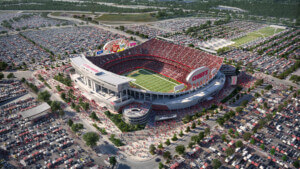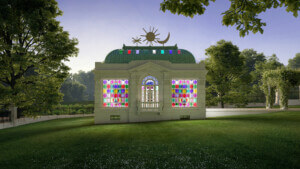A tight budget and short timeline inspired an innovative concrete and terra cotta facade.
BNIM and Moore Ruble Yudell approached the design of the Henry W. Bloch Executive Hall for Entrepreneurship and Innovation at the University of Missouri-Kansas City with two objectives. The first was to express the creative spirit of the university’s program in entrepreneurship, which at that point lacked dedicated support spaces. The second goal was to tie the contemporary structure to its historic surroundings. Moore Ruble Yudell, who developed many of the project’s interior concepts, tackled the former, creating flexible classroom and laboratory spaces and a multi-story amphitheater that doubles as casual seating and a venue for school-wide gatherings. As for the latter, BNIM designed a multicolored terra cotta envelope that balances singularity with connection. “The idea was to create a building that sat by itself, but somehow bring it into context in terms of materials,” explained BNIM senior project architect Greg Sheldon.
Because so much of the existing campus architecture featured masonry construction, the architects “had a desire to use a fired earth material, but to try to do it in a more contemporary way,” said Sheldon. Inspired by a project in London that combined different colors of terra cotta to blend it into its surroundings, BNIM began working with architectural terra cotta manufacturer NBK to design a rain screen for Bloch Hall. But budget and time constraints soon intervened. To cut costs and enclose the building as quickly as possible, BNIM approached Enterprise Precast Concrete about the possibility of casting the terra cotta components directly into insulated concrete panels. “There was a lot of back and forth between Enterprise Precast Concrete and NBK,” said Sheldon. “This was one of the very early projects to use this technique.”
To further streamline construction, BNIM and Moore Ruble Yudell decided to integrate the concrete into the interior aesthetic, so that the inside face of the panels required no additional finishing beyond sandblasting. General contractors JE Dunn Construction “loved that if we could pull this off, the insulation’s in place and the inside’s finished,” said Sheldon. “They bring it out, put it on the building, and that’s it.” For glazing, the design-build team ordered a YCW 750 XT high performance curtain wall from YKK, sized to slot into the opening between the building’s masonry components. Together, the insulated concrete-terra cotta panels and high performance glass helped put the building on track to earn LEED Gold certification.
- Facade Manufacturer Enterprise Precast Concrete
- Architects BNIM, Moore Ruble Yudell
- Facade Installer JE Dunn Construction
- Location Kansas City, MO
- Date of Completion 2013
- System precast concrete with embedded terra cotta elements, high performance glass curtain wall
- Products NBK architectural terra cotta, YCW 750 XT high performance curtain wall from YKK
The patterns in the terra cotta “weren’t accidental, but were studied and studied,” said Sheldon. The south end of the building is a deep red, like the adjacent Bloch School Building. To the north, the colors fade to a buff yellow, reflecting the lighter tones of the nearby student center. To perfect the patterning, the designers first looked at the range of colors available through NBK and chose the six most compatible with the surrounding buildings. They then unfolded the elevation of the building and plugged the different shades into their digital model. BNIM experimented with different combinations, printing each and pinning it to the wall before making adjustments. “I don’t know how many iterations they did,” said Sheldon. “It just went on and on.” The final scheme achieves the desired effect. In color and materials, it creates a dialogue with the older buildings around it. Yet the bold patterning simultaneously marks the facade as a 21st century creation.
Upon receiving the $32 million gift from Henry W. Bloch that made building the new Bloch Hall possible, then-Dean Teng-Kee Tan observed that “the path of innovation is never a straight line.” The architects manifested the analogy in the building’s architecture and landscaping, carving the interior into a series of curvilinear spaces, and connecting the building to its neighbors via a meandering path. But the statement applies equally to the design process itself, in which a tight budget and 14-month construction timeline encouraged an innovative combination of concrete, terra cotta, and high performance glass. A successful sublimation of limitations into opportunity, the story of Bloch Hall’s envelope is the story of entrepreneurship in microcosm.










